Complete Solutions to QUESTION BANK-20 of chapter ATOMIC STRUCTURE of Class 8 book with complete answers and questions
| Class 8 | CHEMISTRY |
| Chapter | ATOMIC STRUCTURE |
| S CHAND IIT JEE FOUNDATION | QUESTION BANK-20 |
| Number Of Questions | 100 |
| Academic Year | 2023-24 |
The force of attraction which holds the different particles together in a molecule is called ___
View SolutionChoose the elements with electropositive and electronegative valency.

View SolutionWho was the first Indian philosopher who had postulated that matter is divisible?
View SolutionWhat is atomic mass unit (amu)?
View SolutionWhat do you understand by atomic mass of an element?
View SolutionTwo types of atoms of chlorine have atomic masses 35 and 37, then why is the atomic mass of chlorine taken as 35.5?
View SolutionWhat is the difference between mass number and atomic mass?
View SolutionDiscovery Of Neutrons is by ?
View SolutionHow was the stability of atom explained by Bohr's model?
View SolutionWhy is atomic number always calculated from the number of protons in the nucleus and not from the number of electrons present in the extra nuclear part?
View SolutionAtomic number of chlorine is 17. What will be the atomic number of chloride ion `(Cl^(-))` and why?
View SolutionAtomic number of sodium is 11. What will be the atomic number of sodium ion `(Na^+)` and why?
View SolutionWhat are the postulates of Bohr's model of atom? How does Bohr model overcome the drawback of Rutherford's model of atom?
View SolutionWhy are atomic masses of most of the elements fractional and not whole numbers?
View SolutionWhy does helium exist as He whereas hydrogen exists as `H_2`
View SolutionName the three isotopes of hydrogen. How do they differ from each other?
View SolutionM-shell can have up to 18 electrons, then why does potassium (Atomic number 19) does not have the electronic configuration 2, 8, 9 ?
View SolutionWhat are the different isotopes of oxygen? Write their symbols and draw their complete structures. In what respects do they differ from each other?
View SolutionAs we move away from the nucleus, in atom the potential energy of electron increases, the total energy as a whole increases. What happens to the kinetic energy of the electron?
View SolutionCould a nucleus of more than one proton but no neutrons exist? Explain.
View SolutionThe valence shell of an element `""_(20)^(40)X` is the 3rd shell.
View SolutionAccording to Bohr's atomic model, electrons revolve around the nucleus in elliptical orbits.
View SolutionThe mass number of the atom of an element is the sum of the number of protons and neutrons in the atom. (True / False)
View SolutionThe maximum number of electrons present in the 5th shell is 32. (True / False)
View SolutionState True or False
Electrons present in the first orbit cannot lose its energy.
View SolutionJ.J. Thomson proposed that the nucleus of an atom contains only nucleus.
View SolutionA neutron is formed by an electron and a proton combining together. Therefore, it is neutral.
View SolutionThe mass of an electron is about `(1)/(2000)` times that of proton.
View SolutionThe statements below are false. For each statement, replace the underlined term to make a true statement.
Electrons have a positive charge.
View SolutionThe statements below are false. For each statement, replace the underlined term to make a true statement.
All atoms of the same element contain the same number of neutrons.
View SolutionThe statements below are false. For each statement, replace the underlined term to make a true statement.
Protons have no electrical charge.
View SolutionThe statements below are false. For each statement, replace the underlined term to make a true statement.
The atomic number of an element is the number of protons and neutrons in the nucleus.
View SolutionThe statements below are false. For each statement, replace the underlined term to make a true statement.
The mass number is an average of the masses of all naturally occurring isotopes of an element.
View Solution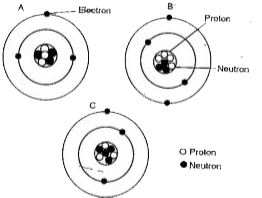
Which diagram represents,isotopes of the same element?
View Solution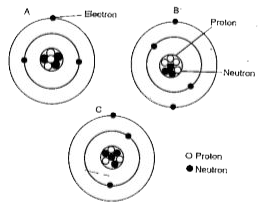
What is the atomic number for A?
View Solution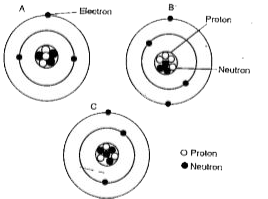
What is the mass number for B?
View SolutionClassify the following elements as metals, non metals and inert gases and give reasons in support of your answer.
Chlorine, Magnesium, Argon, Phosphorus, Potassium, Sulphur, Neon
View SolutionUse the following terms in the same sentence proton, neutron, and isotope.
View SolutionComplete each of the following sentences
An atom's _________ is equal to the number of protons in nucleus.
View SolutionComplete each of the following sentences by choosing the correct term from the word bank.
Anatom's _____ is equal to the weighted average of the masses of all the naturally occurring isotopes of that clement.
View SolutionMatch the entries in column A with the appropriate ones in column B.
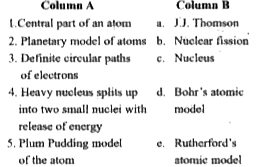
View SolutionAll matter is made up of atoms. Which sentence correctly describes atoms?
View SolutionWhat are the negatively charged particle inside an atom called?
Use the diagram to answer this questions
View SolutionThe black circles in the model represent neutrons. What do the white circles represent?

View SolutionThe atomic number of an element is determined by
View SolutionWhich of the following particles has no electric charge?
View SolutionHow many protons does an atom with an atomic number of 23 and a mass number of 51 have?
View SolutionWhich of the following determines the identity of an element?
View SolutionIsotopes exist because atoms of the same element can have different numbers of
View SolutionWhich of the following pieces of equipment was used by J.J. Thomson to find electrons?
View SolutionWhich one of the following is true of a neutron?
View SolutionThe ratio between the neutrons in C and Si with respect to atomic masses 12 and 28 is:
View SolutionThe number of electrons in the atom of an element X is 18 and the number of neutrons is 22. Which of the following is the correct representation of an atom of this element?
View SolutionAn atom differs from its ion in
View SolutionThe least reactive element among the following is
View SolutionThe diagram given below represents an atom of

View SolutionThe number of valence electrons in is `""_(15)^(31)X` is
View SolutionWhich of the following particles is largely responsible for the chemical behaviour of elements?
View SolutionWhich of the following atoms do not usually form bonds?
View SolutionWhich types of atoms usually become negative ions?
View SolutionWhich element has a full outermosť energy level containing only two electrons?
View SolutionWhat type of element tends to lose electrons when it forms bonds?
View SolutionWrite the electronic configuration, number of valence electrons and classify the following as metals, non-metals and inert gases.
(i) `""_(12)^(24)P`
(ii) `""_(19)^(39)Q`
(iii) `""_(7)^(14)R`
(iv) `""_(18)^(40)S`
(v) `""_(8)^(14)T`
View SolutionWhich of the following describes what happens when an atom becomes an anion with a 2 charge?
View SolutionWhich pair of atoms can form an ionic bond?
View SolutionThe atomic number of an element is 15. Hence, it will show a valency of
View SolutionThe valency of which of the elements is zero?
View SolutionWhich of the following statements is always correct?
View SolutionThe number of valence electrons present in noble gases is:
View SolutionOxygen has an atomic number of 8. Which of the following could form the nucleus of an isotope of oxygen?
View SolutionAn atom of element X contains 3 protons, 3 electrons and 4 neutrons:
What is its atomic number?
View SolutionAn atom of element X contains 3 protons, 3 electrons and 4 neutrons:
What is its mass number?
View SolutionAn atom of element X contains 3 protons, 3 electrons and 4 neutrons:
Write the electronic configuration of the element
View SolutionAn atom of element X contains 3 protons, 3 electrons and 4 neutrons:
State whether element X is a metal or non-metal. Why?
View SolutionAn atom of element X contains 3 protons, 3 electrons and 4 neutrons:
What type of ion, cation or anion, will be formed by an atom of element X? Why?
View SolutionAn atom of element X contains 3 protons, 3 electrons and 4 neutrons:
Write the symbols of the ion formed by an atom of element X.
View SolutionAn atom of element X contains 3 protons, 3 electrons and 4 neutrons:
What could element X be?
View SolutionAtomic models have been improved over the years. Arrange the following atomic models in the order of their chronological order.
(i) Rutherford's atomic model (ii) Thomson's atomic model
(iii) Bohr's atomic model
View SolutionFor an atomic number 20, the 20th electron will occupy
View SolutionMembers of which of the following have similar chemical properties?
View SolutionThe number of electrons in an element with atomic number X and mass number Y will be
View SolutionThe relative atomic masses of many elements are not whole numbers because
View SolutionAtoms of which of the following have a valency equal to zero.
View SolutionCalculate the number of electrons, protons and neutrons in sodium atom. Given that atomic number of sodium is 11 and mass number (atomic mass) is 23.
View SolutionThe nucleus of the atom of an element contains 17 protons and 18 neutrons. Calculate the atomic number and mass number of the element and represent them along with the symbol of the element.
View SolutionThe atom of an element has 2 electrons in the M shell. What will be the atomic number of the element? Name the element.
View SolutionAtomic number of Alis 13 and mass number is 27 .Calculate the number of electrons protons and neutrons in the ion formed Represent the ion.What will be its valency?
View SolutionAn element has atomic number 15. What will be the valency/valencies shown by it?
View SolutionAn ion `M^(3+)` contains 10 electrons and 14 neutrons. What are the atomic number and mass number of the element M? Name the element.
View SolutionAn ion `X^(2-)` contains 10 electrons and 8 neutrons. What are the atomic number and mass number of the element X? Name the element.
View SolutionCalculate the number of protons, neutrons, and electrons in an atom of zinconium-90 that has no overall charge and an atomic number of 40.
View SolutionCalculate the atomic mass of chlorine, which consists of 76% of all the chlorine in nature, and chlorine - 37 that makes up the other 24%.
View SolutionCalculate the atomic mass of silver, which occurs naturally as 52% silver - 107 and 48% silver - 109.
View SolutionCalculate the atomic mass of silicon, which occurs naturally as 92% silicon -28, 5% silicon - 29, and 3% silicon - 30
View SolutionThe ion of an element has 3 positive charges. The mass number of atom of this element is 27 and the neutrons is 14. What is the number of electrons in the ion ?
View SolutionHow many electrons does an atom with an atomic number of 20 and a mass number of 42 have?
View SolutionWhich of the following do not represent Bohr's model of atom correctly?
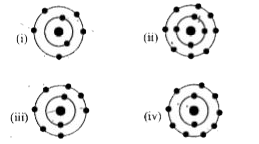
View SolutionIdentify the `Mg^(2+)` ion from the figure where, n and p represent the number of neutrons and protons respectively.
View SolutionElements with valency 1 are
View SolutionUse the following terms to create a concept map
atom, nucleus, protons, neutrons, electrons, isotopes, atomic number, positively charged, negatively charged, neutral, Rutherford, J.J. Thomson, Goldstein, Chadwick
View Solution
QUESTION BANK-20 questions and complete solutions for chapter ATOMIC STRUCTURE of S CHAND IIT JEE FOUNDATION of Class 8